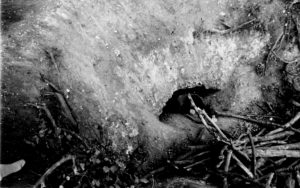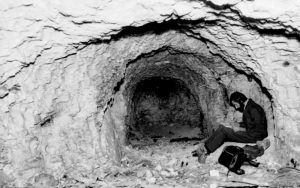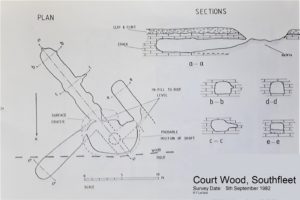A set of chalk tunnels in Court Wood, Southfleet were brought to the attention of the Kent Underground Research Group in September 1982 by a local resident in nearby New Barn Road.
The tunnels were entered via a crater like hollow on the northern edge of the wood at NGR TQ 6205 6992. This depression marks the site of the collapsed original entrance shaft. The longest gallery was found to be 12.5m long and 1.7m high so that some form of underground transport, probably a simple barrow, must have been used to carry the chalk from the working face. This contrasts with the simpler denehole excavations where the chalk was hauled up directly from the face. In comparison with a mediaeval denehole, the galleries at Court Wood had been crudely cut with little care taken to trim the walls or roof. It was this lack of care or skill that probably lead to the collapse of the shaft. Another contributing factor was that very little chalk had been left for roof thickness, with only 1.7m separating the roof from the surface. There have been a number of similar small mines recorded in the area as well as mediaeval deneholes and 19th century chalkwells.
No definitive dating evidence was found but the style of mining and the lack of knowledge of mining mechanics would suggest that it was a small mine dug for agricultural chalk by local farm labourers in the late 18th early 19th century.


